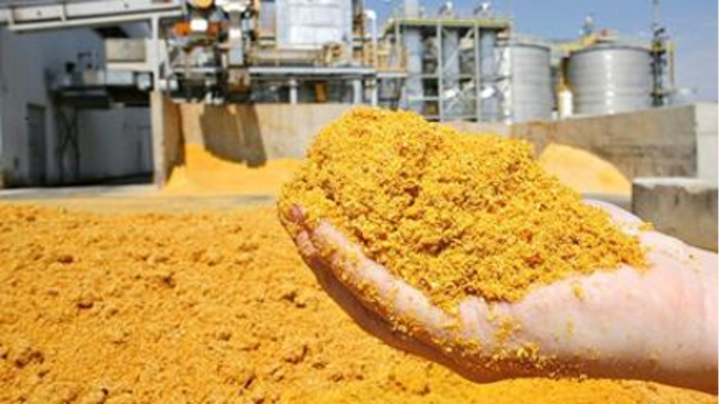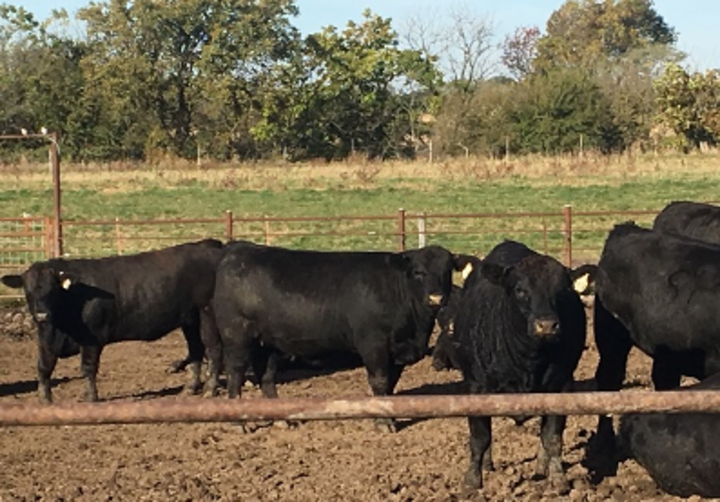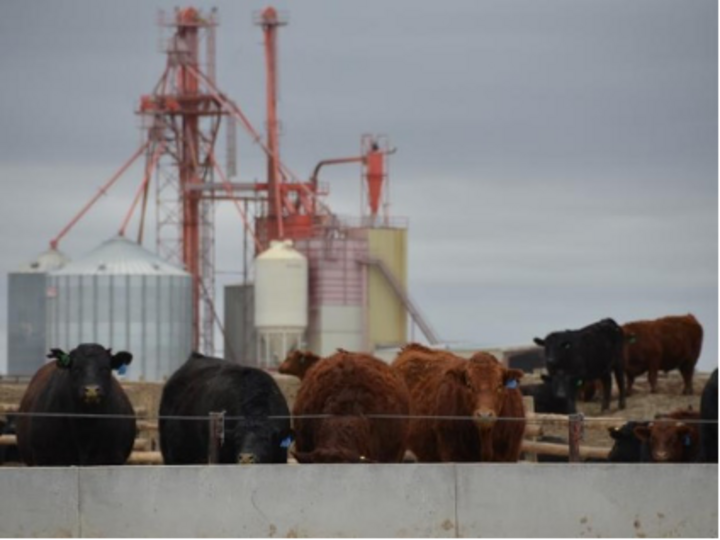Phase feeding protein in beef cattle diets to mitigate excreted nitrogen
This article is written by a University of Nebraska-Lincoln student, Caitlin Coulson, as part of their Animal Manure Management class in Biological Systems Engineering. It has been reviewed by experts to encourage accuracy of issues presented. The article represents the student’s understanding of the subject addressed at this stage in her career. Rick Koelsch, faculty instructor.
Supplemental protein has historically been the most expensive component in beef cattle diets. However, over the past 20 years with the rapid expansion of ethanol production and distillers grains supply, rations have changed. Midwest and High Plains feedlot diets have become excessive in dietary crude protein due to the widespread availability and use of generally inexpensive, high protein distillers grains and other by-products from ethanol production.

Are High Distillers Grain Rations a Concern?
The combination of over-feeding crude protein and phosphorus causes higher manure nitrogen and phosphorus excretion. The major locations of cattle feeding focused on the Midwest and High Plains concentrates these nutrients in a relatively small geographical area. This combination causes environmental concerns. Manure environmental concerns are related to nutrient accumulation in soils, higher runoff risks, and volatilization of nitrogen, which can then return to the land or water through rainfall, dry deposition, or direct absorption (Klopfenstein et al., 2002; Van Horn et al., 1996). Consequently, this highly concentrated manure must be distributed on greater crop land acres, which provides a challenge. Therefore, the excess nitrogen and phosphorus may become an environmental and sustainability concern that needs to be addressed by cattle producers and farmers moving forward.
Phase Feeding to Reduce N Losses
As cattle grow, their protein requirements, as a percentage of the diet, decreases due to an increased proportion of fat deposition relative to protein as the animal approaches maturity. Theoretically, if the same diet is fed throughout the finishing phase while the requirement for protein by the animal decreases, then the amount of excreted nitrogen will increase and be wasted. So logically, we may be able to decrease the relative crude protein concentration in diets as the animal matures without negative effects on animal performance, and overall may result in less total nutrients into the manure. So, how do we more accurately meet the needs of the cattle and does it really work to reduce excreted nitrogen?
So, how do we more accurately meet the needs of the cattle and does it really work to reduce excreted nitrogen?

Klopfenstein and Erickson (2002) at the University of Nebraska – Lincoln demonstrated the idea of phase feeding protein to meet the needs of cattle as they mature in both yearlings and calf-feds. The diets fed in these studies, typical for the Midwest and High Plains, met all metabolizable protein requirements of the animals and contained 92.5% concentrate. The standard diet was formulated to provide 13.5% crude protein, which is common to meet (or exceed) the protein requirements of the animals. The phase-fed protein diets were altered to meet the protein requirements of the animals at that stage. The experimental diets were altered every 14 to 28 days during the “finishing phase” which lasted 54 to 73 days. As protein was phase-fed to both yearlings and calf-feds, feed efficiency was improved by 4 to 5% and nitrogen excretion was decreased by 22% and 13% in yearlings and calf-feds, respectively. Furthermore, total N volatilization was reduced by 32% and 15% compared to the standard diet for yearlings and calf-feds, respectively. Differences in pen surface volatilization is likely attributed to the time of year, with calf-fed studies being conducted in the winter vs yearlings fed during the summer months.
Similarly, Vasconcelos and colleagues (2006) conducted a study in the Texas Panhandle to evaluate the effect of phase feeding protein on animal performance and pen surface nutrients. Steers were fed a common diet formulated at 13.0% crude protein for 62 d, and on d 63 steers were assigned a diet containing 13, 11.5, or 10% crude protein for the finishing period (d 63 to 110). Again, there were no effects on animal performance or carcass traits, but less nitrogen was excreted and volatilized. Less nitrogen being volatilized led to a greater proportion of less nitrogen deposition on fragile ecosystems negatively impacted by excess nitrogen and possibly lower economic cost for the feedlot.
While there are many examples of reducing dietary crude protein and nitrogen excretion without affecting animal performance, Cole et al. (2006) observed a decrease in performance for steers fed a steam-flaked corn diet and given an aggressive implant strategy when phase feeding of protein was implemented. This may suggest that the protein requirements of these animals were not completely satisfied due to higher requirements observed with highly digestible diets and implanting steers. However, the reduction in excreted nitrogen and volatilization were still observed at the expense of cattle performance.
By this point, the alteration in nutrient content of excreted manure is clear with phase feeding protein but may come at the expense of cattle performance. However, the negative affect on performance from phase feeding protein is generally observed in highly digestible diets. These diets require more ruminally available protein for optimal rumen function and therefore, may be deficient in lower protein diets. There are models available that can accurately predict the specific protein requirements of cattle relative to body size, mature body weight, and diet and additional help from a nutritionist is warranted.
Challenges with Phased Feeding?

Overall, it is challenging to accurately implement precision feeding. To effectively utilize these strategies, it is imperative that feedlots have an accurate assumption of current body weight, intake, protein requirements of cattle, and protein values of current feedstuffs. On top of that, some feedlots are logistically not able to adjust rations on a pen by pen basis and are limited by the total batches of feed per day their feed mill can make, making this practice challenging to implement. Furthermore, cost of gain becomes a limiting factor in most of these rations. During certain times of the year, the feedstuffs high in crude protein are inexpensive, readily available, and constitute a large proportion of the diet. By reducing crude protein in the diet, higher priced ingredients may have to take its place, which ultimately affects the bottom line of the operation. Since the ethanol by-products high in crude protein are generally economical to feed, it is difficult to convince producers to remove these ingredients regardless of the impact on manure nitrogen concentration.
Are There Practical Options?
While precision feeding is incredibly difficult, researchers suggest that removing any additional supplemental crude protein (i.e. urea) or generally reducing the crude protein of the diet during the finishing period may be enough to reduce excreted nitrogen (Vasconcelos, et al., 2007). Additionally, feed additives (i.e. beta-agonists) may be implemented in the last 30 days of the feeding period. This requires an additional ration to be fed and may present an opportunity to reduce crude protein of the diet at that time without causing additional strain on the feed mill.
Overall, phase feeding or precision feeding of dietary protein to beef cattle has proven to be an effective method to decrease the amount of excreted nitrogen in the manure. While these strategies seem to have a neutral effect on animal performance, they are rather difficult and potentially cost prohibitive to implement in most feedlots. The reduction of nitrogen in manure from feeding less distillers grain may not outweigh the economic advantage of feeding these generally inexpensive, readily available ethanol by-products. However, good stewardship suggests the need to evaluate options for reducing crude protein in diets.
Additional Resources:
Use of extension personnel or a feedlot nutritionist is imperative to implement a phase feeding strategy appropriately and accurately.
Additional Reading Options:
Phase Feeding Crude Protein to Decrease Ammonia Emissions from Finishing Beef Cattle
References:
Cole, N. A., P. J. Defoor, M. L. Galyean, G. C. Duff, and J. F. Gleghorn. 2006. Effects of phase-feeding crude protein on performance, carcass characteristics, serum urea nitrogen concentrations, and manure nitrogen of finishing beef steers. J. Anim. Sci. 84:3421-3432.
Cole, N. A. and R. W. Todd. Phase feeding crude protein to decrease ammonia emissions from finishing beef cattle. Livestock GRACEnet. USDA ARS. Accessed October 19, 2020.
Klopfenstein, T. J. and G. E. Erickson. 2002. Effect of manipulating protein and phosphorus nutrition of feedlot cattle on nutrient management and the environment. J. Anim. Sci. 80(E. Supp 2):E106-E114.
Klopfenstein, T. J., R. Angel, G. L. Cromwell, G. E. Erickson, D. G. Fox, C. Parsons, L. D. Slatter, and A. L. Sutton. 2002. Animal diet modification to decrease the potential for nitrogen and phosphorus pollution. Council for Agric. Sci. Technol. Issue Paper No. 21. CAST, Ames, IA.
Vasconcelos, J. T., L. W. Greene, N. A. Cole, M. S. Brown, F. T. McCollum III, and L. O. Tedeschi. 2006. Effects of phase feeding protein on performance, blood urea nitrogen concentration, manure nitrogen:phosphorus ratio, and carcass characteristics of feedlot cattle. J. Anim. Sci. 84:3032-3038.
Vasconcelos, J. T., L. O. Tedeschi, D. G. Fox, M. L. Galyean, and L. W. Greene. 2007. Review: Feeding nitrogen and phosphorus in beef cattle feedlot production to mitigate environmental impacts. Prof. Anim. Sci. 23:8-17.
Van Horn, H. H., G. L. Newton, and W. E. Kunkle. 1996. Ruminant Nutrition from an environmental perspective. J. Anim. Sci. 74:3082-3102.
This article was reviewed by Galen Erickson, Nebraska Extension Specialist and Erin Laborie, Nebraska Extension Educator